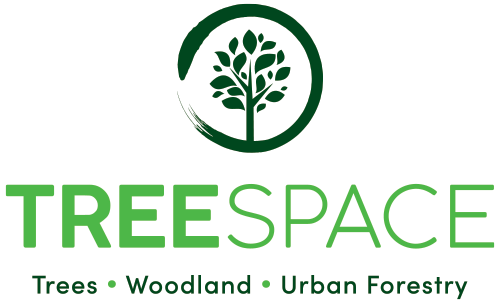Grass Cutting! The NOT so Silent Killer of Urban Trees.
Over the past number of years Tree-space has undertaken tree inventories and arboricultural assessments of thousands of trees in many different land uses. One persistent observation during field operations are injuries or wounds to the tree stem from grass cutting operations. In some cases a large area of the bark has been stripped from the stem or there is a series of small wounds close to the root collar. Stem wounding appears to be a serious landscape issue and it raises questions about the level of knowledge and skill of landscape operatives. It also raises questions regarding landscape design, the value of urban trees, and the potential replacement costs if the tree eventually fails.
Basic understanding of tree biology should be an essential element of any landscape operatives training. Equally landscape design should consider the practical reality of establishing trees in urban parks and grass verges where seasonal grass cutting is a frequent activity.
The outer bark of a tree is a protective layer that is intended to keep the inside of the tree moist and prevent the interference of pests and pathogens. The inner bark is made up of phloem an essential living tissue responsible for transporting sugars around the tree. The cambial zone which is an essential meristematic layer only a few millimetres thick is located between the phloem and the xylem. The xylem are living tissues responsible for the transport of water around the tree. Exposing these essential living tissues to harsh temperature changes, desiccation, and biological threats greatly reduces the trees chances of survival.
Below are some images of the effects of grass cutting operations on urban trees. Mechanical injuries to tree stems are preventable. There are two examples below of potential landscape solutions. Mulching around the base of the stem or maintaining a grass free area have many benefits for tree growth and development.
Young Sorbus tree with a serious injury to the base of the stem. The bark and cambial zone has been damaged and there is a cavity in the stem. The tree had poor vitality and was highlighted for removal.
Young Lime (Tilia) tree with a section of the bark stripped. If the wounding continues around the base of stem it is unlikely that the tree will survive.
Young Birch (Betula) with stem damage. The bark has been removed in a section of the stem exposing the living tissues to drying and pathogens.
Cherry plum (Prunus pissardii) in the National Botanical Gardens with a grass free mulched area around the base of the stem. The mulch protects the stem from mechanical injury and has the added benefit of encouraging fine root development.
Magnolia x soulangeana with a grass free area around the base of the stem





